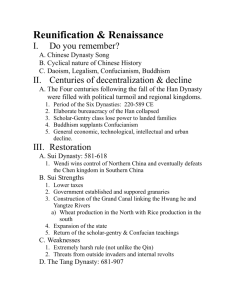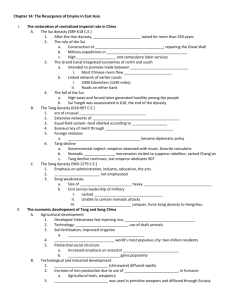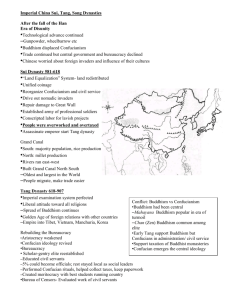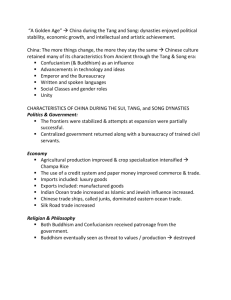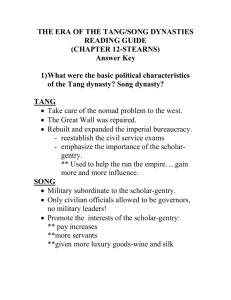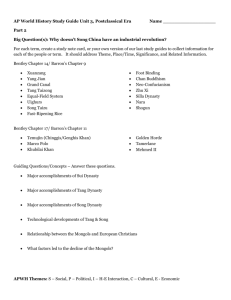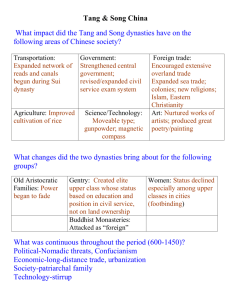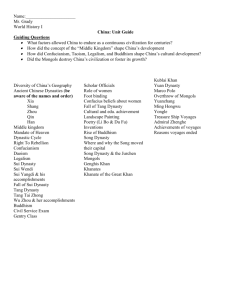Post-Classical China PPT
advertisement
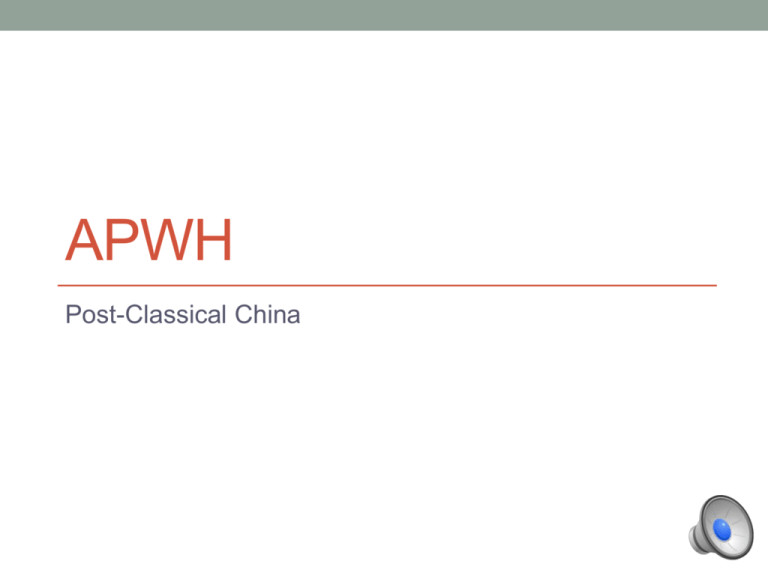
APWH Post-Classical China Big Ideas • Post-Classical China = Sui, Tang, Song, Yuan, Ming • Today we will focus on the Sui, Tang, Song • How did China change following the fall of the Han? How did they stay the same? • What impact did China have on the post-classical era? Smaller Ideas – But Important! • Due to advancements in agriculture, China’s population is • • • • • going to BOOM! Confucianism is revived through the civil service exam Buddhism spread to China in the Classical era … what happens during the Post-Classical era with this religion? Women’s status will decline Significant advancements in innovations and technology will occur in the Tang and Song (Golden Age) Loss of control over the Silk Road will result in China seeking trade in the Indian Ocean Important Vocabulary • • • • • • • • • • • Granaries Grand Canal Pure Land Buddhism Zen (Chan) Buddhism Scholar-gentry class Civil Service Exam Jinshi Kowtow Neo-Confucianism Flying Money Junk CHINA Sui, Tang and Song How was China the focal point of Asia? What impact did China have upon the World? Sui Dynasty 589-618 • 589- Wendi • Unites northern and southern China • Buddhist • Lowered taxes • Granaries Yangdi [son of Wendi] • Milder legal system • Promoted scholar-gentry in imperial administration by • Upgrading Confucian education • Scholar-gentry re-established • Restored examination system • Grand Canal completed—helps to feed people • 1 million build canal almost half die • Thousands die rebuilding Great Wall Widespread revolts due to war losses In 618 he was murdered by his own ministers Agricultural Advancements • Fast-growing rice • Farmers in south harvested two crops per year • Improved agricultural techniques • Heavy iron plows • Extensive irrigation systems • Use of manure and organic materials • Terraced mountain farming Tang Dynasty 618-907 • Reconquers lands in north and west • Extends influence to Korea • Tributary states in Vietnam, Tibet, and Korea • Empress Wu • Only woman to hold title of emperor • • • • Expanded roads and canals Promoted foreign trade Promoted agricultural improvements Equal Field System Tributary System • Foster trade and cultural exchanges • Promote diplomatic relations in east Asia • Kowtow and exchange of gifts as part of ceremonies Korea Vietnam •Benefitted with opening of Chinese markets for Korean goods •More hostile with revolts vs. China •Adopted Chinese agricultural practices •Less patriarchal than China Confucianism during the Tang Dynasty • What role did it play? • How were the Scholar-gentry involved with this? • Was it exclusive? • Was it monitored? Civil Service examination revived Scholar-gentry Special status for office holders Jinshi = highest offices achieved by passing the more difficult exams on Chinese literature. Family connection still helpful. The Examination System • What was its purpose? • Who administered the exams? • What were the exams based upon? • What was the role of families and birth? Religion • Strong social, economic, and political force • Early Tang continued to patronize Buddhism while promoting Confucian classics • State patronage of Confucian learning threatened old aristocratic families and Buddhist monastic orders • Mahayana or pure land • Refuge from war and turmoil • Chan or Zen • Appealed to educated • Meditation and appreciated for natural beauty Empress Wu and Buddhism • Tries to elevate it to status of state religion • Commissions Buddhist paintings and sculptures Anti-Buddhist Backlash • Attacked by Confucian and Daoist rivals • Scholar-administrators—they posed economic challenge to imperial order • because monastic land not taxed and therefore they lost revenue • Lost labor power because they could not conscript peasants who worked on monastic estates • Restrictions imposed on land and resources for monastic orders • Restrictions grew into persecution • Thousands of monasteries and shrines destroyed • Monks and nuns forced to return to civilian life • Survived but never regained political and economic influence • (Emperor Wuzong persecutes Buddhists) Buddhist-Confucian Conflict • Early Tang acceptance of Buddhism • Which leader strengthened it in China? • Monastery construction • Was this a threat? Yes! To who? Why? • Results • What was the “new” central ideology that emerged? Fall of Tang • Poor leadership--Yang Guifei leads emperor astray Fall of Tang • Heavy taxation burdens people but still not enough for military and building projects • 751 defeat at Battle of Talas River against Muslims • An Lushan [foreigner] led unsuccessful revolt 755 • Worsening economic conditions • Border attacks and rebellion • 907 capital sacked Song Dynasty 960-1279 • Paid tributes to northern enemies but failed to stop threat • Khitans from Manchuria • Their Liao dynasty recognized the Song’s cultural superiority (Sinified) • Confucian scholar-gentry gain power and status • Number of bureaucrats grew • High pay • Little to do Now in the Song era, the bureaucrats are finally more powerful than the aristocratic families and the Buddhists With the stress on Confucianism Neo Confucianism • Neo=New • New strict form of Confucianism • Virtue could be attained through book learning and personal observation • Hostility to foreign philosophical systems • Less receptive to foreign influences and ideas • Stifles innovation and critical thinking as time passes • Emphasis on rank, tradition, obligation • Reinforced class, age, and gender distinctions • Patriarchal Effects of Neo-Confucianism which endure today 1. simplified rituals and behaviors for of society 2. strengthen patriarchy 3. spiritual needs acknowledged 4. reinforce hierarchies each segment Decline of Song • Challenges from nomadic peoples from north continued • Tribute for protection costly • Cost of army • Emphasis on civil administration and scholar-gentry • Funds diverted from military needs to scholarly and entertainment pursuits Wang Anshi as Chief Minister • Reforms • Legalist basis • Cheap loans and government assisted irrigation projects to promote agricultural growth • Taxed landlord and scholarly class who had been exempted from military service • Used money to establish well trained army • Education emphasized critical thinking rather than rote memorization of classics • Lost support and reforms reversed • Neo-Confucians came to wield greater influence and ended Wang’s attempts at reform Southern Song Jurchens overthrow Khitans and establish Jin Dynasty in 1127 • Overran Song territory to the Yangtze Valley Southern Song • Rapid economic growth • Merchants grew rich from trade • Culturally the most glorious era in Chinese history Changes in China • Population doubled from Tang-Song • 100 million • 10 cities with 1 million • Agricultural Advances • new type of rice helped to feed growing population Agrarian Production • Peasants encouraged to move to uncultivated areas • State regulated irrigation • Canals increased markets for crops • New types of rice to feed growing population • Manures • Wheelbarrow • Policies to redistribute land from large landholders to free peasants • Weakened powerful aristocracy Commercial Organization and Imperial Supervision • Cities’ market quarters—local Changan, Song capital products, artisan production, overseas trade goods • Hours and marketing measures regulated • Guilds • “deposit shops”—first use of paper money (flying money) • credit Silk Road Linked China with west for growing trade Watertight bulkheads, sternpost rudders, oars, sails, compasses, bamboo fenders, gunpowder-propelled rockets for self-defense. Chinese junks Arab dhow Hangzhou Advancements Woodblock Printing Tang Dynasty 700’s Moveable type Sung Dynasty 1040 Gunpowder 800’s Paper money 1020’s Magnetic compass 1100’s Poetry and Art • Tang poetry • Praised Confucian virtues and orderliness • Song art • Daoist influence • Use of black ink Changes in Society • More mobile as more move to cities • Civil service=advancement • Old aristocratic family power declined • Scholar-gentry--officials rose in status • Education rather than land ownership gave status • Urban middle class • Merchants, shopkeepers, skilled artisans, minor officials • Urban lower class • Laborers, soldiers, servants • Peasants • Toiled for wealthy landowners Women • Always seen as subservient to men • Decline more during Tang and Song • Especially upper class in cities • Women’s work less important to family’s prosperity and status • Foot binding • Peasant women affected less as they worked fields and helped produce food and income The Mongols are Coming!! 1279—Kublai Khan conquers the Southern Song beginning Mongol rule of China known as the Yuan Dynasty Important Vocabulary • • • • • • • • • • • Granaries Grand Canal Pure Land Buddhism Zen (Chan) Buddhism Scholar-gentry class Civil Service Exam Jinshi Kowtow Neo-Confucianism Flying Money Junk Big Ideas • Post-Classical China = Sui, Tang, Song, Yuan, Ming • Today we will focus on the Sui, Tang, Song • How did China change following the fall of the Han? How did they stay the same? • What impact did China have on the post-classical era? Smaller Ideas – But Important! • Due to advancements in agriculture, China’s population is • • • • • going to BOOM! Confucianism is revived through the civil service exam Buddhism spread to China in the Classical era … what happens during the Post-Classical era with this religion? Women’s status will decline Significant advancements in innovations and technology will occur in the Tang and Song (Golden Age) Loss of control over the Silk Road will result in China seeking trade in the Indian Ocean

